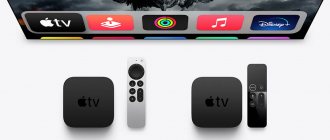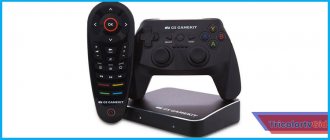Many users have heard about the capabilities of smart TVs, but cannot use them because they recently purchased a model without Internet access. It’s too early to replace it with a new one, so set-top boxes with Wi-Fi for digital television will be an option to correct the situation. By purchasing such a device, the user gets the opportunity to watch digital broadcasting, access the Internet and other useful functions.
Advantages of models with Wi-Fi
A good TV set-top box for digital television with Wi - Fi is more expensive than models without wireless Internet support, but it also has more useful features . Modern digital set-top boxes with Wi-Fi have the following advantages.
- The DVB-T2 tuner provides access to digital TV if the TV does not have a built-in feature.
- Connecting to wireless Internet makes it possible to access online Cinemas.
- You can install applications on the set-top box.
- Various connectors on the tuner allow you to connect peripheral devices through it.
- The built-in media player allows you to watch content from external drives.
- You can connect a mouse and keyboard through the console, making using the Internet more convenient.
- With a built-in browser, the user gets full access to the Internet, just like on a PC.
Important! It should be understood that not every set-top box with Wi-Fi has the full range of the above functions. Depending on the model, they may be limited to one or another number of possibilities.
Comparison of characteristics and prices
If you don’t yet know which smart TV set-top box with Wi-Fi to choose for your TV, then you can study our comparison table, in which we have indicated the key points of each model and their average price.
| Model | operating system | HD support | Processor/chipset name | Dimensions, mm. | Weight, g. | Average price, rub. |
| Google Chromecast 2018 | Chrome OS | Full HD | Armada 1500-mini | 52x14x52 | 40 | 3 590 |
| Xiaomi Mi Box S | Android TV 8.1 | 4K UHD | Amlogic S905X | 95x17x95 | 147 | 5 080 |
| Rombica Smart Box 4K | Android 4.4 | ARM Cortex-A7 | 107x27x114 | 198 | 5 290 | |
| iconBIT Movie SMART TV | Full HD | ARM | 119x28x119 | 145 | 5 620 | |
| Dune Neo 4K Plus | Android 6.0 | 4K UHD | Amlogic S905X | 101x18x101 | 108 | 7 990 |
| Apple TV 4K (32GB / 64GB) | TVOS | Apple A10X Fusion | 98x35x98 | 425 | 14 200 | |
| Dune HD Pro 4K | Android 6.0 | Realtek RTD1295 | 188x27x128 | 51 | 16 990 |
What resolution do you plan to buy?
Full HD
68.27%
4K
31.73%
Votes: 104
Principle of operation
A digital receiver with Wi-Fi for a TV has two main functions, they work according to the following principle.
- The built-in DVB-T2 tuner converts the analog signal and provides access to free digital TV.
- The built-in Wi-Fi adapter receives the signal from the router and provides Internet access. Moreover, depending on the model, the user may either have limited functionality - built-in access to cinema halls and several pre-installed services, or the set-top box has an operating system (mainly Android), which opens up broader functions. If the OS is installed, the TV becomes a full-fledged analogue of Smart TV.
How to choose a console
Choosing the right receiver is the key to the fact that it will perform its functions efficiently, and the user will be able to enjoy not only watching TV, but also quickly surfing the Internet.
Important! TV sets and set-top boxes are usually produced by different companies. Therefore, looking for information about the compatibility of one device and another is a pointless exercise.
You can also find recommendations that a tuner should be selected based on the power of its existing Wi-Fi receiver. This is the second misconception, which if adopted by the user will waste time and nerves, because he simply will not find such information, and not a single seller in the store will provide it. The parameters to consider when purchasing are as follows.
- Processor clock speed and amount of RAM. In most cases, set-top boxes are equipped with quad-core processors with different clock speeds - the higher it is, the better. The principle of choosing RAM is similar.
- Supported television standards. A set-top box for receiving digital television must have support for DVB-T2 and, if possible, DVB-C (cable television).
- Supported Wi-Fi standards. Such information is not always written on the box or instructions. If it is not there, then the set-top box with a Wi-Fi receiver operates at a frequency of 2.4 GHz. If the receiver is more advanced, then it will be able to operate on a less congested 5 GHz channel, that is, access to the Internet will be faster. The manufacturer will definitely make a note about this, as this is a serious advantage.
- Availability of an operating system. Many models with Wi-Fi do not have operating systems, and their Internet functions are represented by a pre-installed set of software - support for popular cinemas, the ability to broadcast content from mobile devices through the set-top box, weather. If the tuner runs on an operating system (mainly Android), then it will provide full access to the Internet and the application store, which will allow you to install any programs - from browsers and players to games.
- A DVB-T2 receiver with Wi-Fi can output a signal from external memory or record information to it. In this case, you should check which media are supported on the receiver. This depends on the USB interface (they may not provide power), which are designed for either memory up to 500 GB or larger hard drives. You also need to find out what file systems the tuner can work with. Ideally, there should be support for NTFS, otherwise files larger than 4 GB will not be able to be loaded onto a flash drive.
- Image resolution. To watch content in high quality, the device must support FHD.
- Antenna type. When receiving a signal via Wi-Fi, its quality will largely depend not on the built-in adapter of the set-top box, but on the power of the router. However, some tuner models are equipped with remote antennas, which means a more powerful receiver. If you purchase a TV tuner that is located far from the router, and you have no desire to change the latter, then you should buy a model with an external rather than a built-in antenna. Some DVB-T2 receivers with Wi-Fi can act as a repeater, that is, they not only receive the wireless network, but also broadcast it further.
- Built-in memory. Its presence allows you to install applications and record content directly to the set-top box.
- Outputs on the body. To connect to a TV, it is best to use an HDMI connector, as it produces the best image quality. It is also recommended to choose models with multiple USB outputs, which makes it possible to connect not only an external drive, but also a mouse for better navigation.
Why do you need a SMART TV set-top box with WiFi for your TV?
Nowadays, almost every home has at least one TV. Some families have several of these devices installed in different rooms. TV has become one of the most common household appliances. The development of progress even allows you to watch movies in 3D.
However, for those who, for certain reasons, cannot afford to purchase a “smart” TV, an alternative has been created - a SMART-TV set-top box. This small device allows you to enjoy the same features and bonuses that even the most expensive TV offers.
Most channels are currently broadcasting in digital broadcast format, which allows for maximum clarity and image quality. Online broadcasts of satellite channels have pause and rewind functions, there is no need to rush to watch your favorite series or movie at a certain time.
Note! Connection to SMART TV can be carried out by a specific operator that provides services, or by the user independently using the Internet. To do this, it is enough to have a router to which the SMART-TV tuner is connected via Wi-Fi.
The domestic consumer electronics market offers a wide range of “smart” equipment for TVs. These devices are suitable for almost any model or modification of the TV, regardless of the country of manufacture and year of manufacture. Using this technique, you can get rid of many problems with connecting to a cable operator. It is enough to have an Internet connection.
The development of the TV set-top box market is due to the fact that the functionality of a regular TV has not changed much over the past 10-20 years. It is possible to catch various channels with excellent image quality, you can configure them yourself, some models allow you to listen to radio stations. That's all. The revolution in this direction was “organized” by intellectual additions to the most important “table decoration for the holiday” - the TV.
Most of these consoles operate using a common operating system called Android. Made in the form of a small plastic block. The size of equipment is constantly decreasing; now there are devices the size of a regular flash drive. However, the most interesting thing is hidden inside, since a huge digital world of information and a variety of entertainment opens up for the user.
Note! A huge advantage of a digital set-top box is that it can be used to turn an ordinary old TV into a fairly modern device. At the same time, the costs of such television are minimal.
The history of “smart” set-top boxes began with the era of the development of the Internet and related technologies. They became widespread about 15 years ago. The fact is that with the advent of affordable network connections, the need to buy a TV for most users simply disappeared. In this regard, various devices were invented that allow you to connect the Internet to a “blue screen”.
In turn, TV manufacturers went their own way, as a result of which they came up with “smart” devices that can connect to the network without intermediaries in the form of set-top boxes and tuners.
Important! The image quality when using a set-top box depends most on the TV.
Definitely, a modern screen can provide a much better image than any other one released at least 5 years ago. However, the difference in price will be very noticeable.
Receiver setup
Wi - Fi receiver connects to your TV in a slightly different way than a regular digital set-top box. The antenna cable is connected to the set-top box itself. If the user plans to watch only over-the-air broadcasts, then communication with the TV can be done through the same antenna cable. If the user’s tasks include using the Internet and viewing content from flash drives, then you will need to use an HDMI connection or tulips (adapter from AV to tulips).
After this, you need to switch to displaying from the selected connector on the TV and configure the receiver. To do this, you will need to use its remote control and follow the instructions that appear on the screen. Most receivers require you to specify the date and time, as well as the region. After the initial setup, the device will offer to find channels (you should select automatic search) and connect to the Internet via Wi-Fi. All available networks will be displayed. Having selected the desired one, the user will be required to enter a password for it.
Important! The setup procedure may differ slightly, so you should look for more detailed recommendations in the instructions for the receiver.
Top 3 digital set-top boxes with Wi-Fi
For those looking for proven models of digital receivers with Wi-Fi, below are the best representatives on the market.
Digifors SMART 200
The Digifors SMART 200 TV tuner is an excellent model with built-in Wi-Fi and the Android 4.4 operating system. The device received a quad-core Amlogic S905D processor with a frequency of 2 GHz and 2 GB of RAM. Own storage – 1 GB, support for hard drives up to 2 TB with FAT16/32 and NTFS file systems. Internet access via Wi-Fi 802.11 g/n (2.4 GHz) or cable connection via an Ethernet connector 10/100 Mbit/s. Maximum video resolution is FHD.
There are built-in services YouTube, IVI and others. The model supports popular cloud services, can work with torrent files, and supports installing APK applications (directly from a flash drive) or from the Play Market. The device understands all modern video and audio formats and codecs, subtitle files and graphic formats.
The set-top box has a familiar interface, like that of Android smartphones, so it’s very easy to understand . In addition, the gadget can record broadcasts, they can be paused or rewinded, and there is a built-in program guide. The model supports Mircast and AirPlay. Connectors – 2 USB, HDMI, antenna input and output, AV, audio, LAN. In addition to the set-top box, the kit includes a control panel, an HDMI cable, an AV cable, and a power supply. A mouse and keyboard are optionally available. The price of the model is from 3,800 rubles.
LUMAX DV-3206HD
TV tuner LUMAX DV-3206HD is a model with Wi-Fi support from a Russian manufacturer. The device received a reliable GX3235S processor and a powerful digital receiver RT850. The device is made in a metal case. The front panel has control buttons, a USB output and a display. On the reverse side there are antenna input and output, HDMI, audio output and tulips. You can use a 3G modem to access the Internet. The set includes a remote control with batteries, a set-top box, and an RCA cable.
Important! The gadget supports MeeCast technology – displaying images from mobile devices.
The device is not equipped with an OS, so Internet access is provided through the proposed services - YouTube, Gmail, Weather, Megogo, LUMAX cinema (100 films available). On-air functions are represented by a pause in the show, an electronic program guide and the ability to record video on a flash drive (support for no more than 500 GB). Video resolution is FHD, there is a functional media player with support for modern codecs. Price from 1,300 rubles.
Jinga JT2-2703
The Jinga JT2-2703 TV tuner is an inexpensive DVB-T/T2/C receiver with a removable Wi-Fi antenna. The model does not have its own operating system, access to the Internet through services - YouTube, Megogo, NEWS&WEATHER, Stalker IP TV.
The device supports the functions TimeShift (pause in the broadcast), PVR (recording to a flash drive), EPG (electronic program guide). Processor - National GX3235S, RAM - 4 MB, main memory - 64 MB. Maximum video resolution is FHD. There is a functional media player for listening to audio and watching video. Interfaces – 2 USB 2.0, antenna input, RCA, HDMI. Includes set-top box, RCA cable, power supply, remote control, Wi-Fi antenna. There is a display on the front panel. Cost from 1,300 rubles.
TOP 5 – network audio players
The implementation of the beautiful concept of transferring a music library from optical discs to network storage is often hampered by the lack of a playback device that matches the class of the rest of the music system. Of course, you can limit yourself to a personal computer slightly modified specifically for this task or use a network multimedia player as such a source, but such a component will be dissonant as part of a serious High-End system.
Let us recall just some of the advantages that the network concept of storing audio recordings provides. First of all, it became possible to go beyond the sound quality requirements of the Red book - in other words, listen to recordings in resolutions exceeding 16 bits / 44.1 kHz. Of course, in your collection of optical discs it is likely that there will be positions in the SACD format or even the bygone DVD-Audio, which made it possible to get acquainted with high resolution before, but today such recordings are increasingly distributed in the form of multimedia files in high-resolution formats DSD, WAV, FLAC, ALAC and the like. Examples of resources that distribute such recordings include HDtracks , HighResAudio , HD Classic . In addition, network technologies have provided hitherto unattainable ease of navigation through large collections of recordings and control of playback. Modern software solutions allow you to create perfect order in your collection - each album will take its place in the virtual storage and will never get lost in the mass of other publications. In addition, it becomes possible to combine your favorite songs into playlists that can be compiled and remembered for various situations. And finally, the size of the music library is now in no way limited by your living conditions and is determined only by the amount of memory allocated for its storage. If we are talking about a home server, then the cost of a terabyte of disk space is now quite affordable, and, unlike high-resolution video, storing music recordings even in the highest quality requires relatively modest amounts of disk memory. For example, even for high-resolution music with 24-bit / 192 kHz parameters, approximately 12,000 tracks or about 1,200 music albums will fit on a 2 TB disk. As a bonus, networking technologies in audio offer additional capabilities. For example, listening to Internet radio stations. Broadcasts on the Internet erase any boundaries, which is physically impossible with broadcasting. Again, there is no limit to the number of available stations, since there is no longer any need to compete for the broadcast frequency range. As a result, on the World Wide Web you can find stations specializing in almost any kind of music.
All that remains is to teach your music system to work with content posted on the Internet. a regular computer can handle the task of playing music from the network . We, of course, will not seriously consider the option of using it autonomously to listen to music through multimedia speakers or laptop speakers, but by equipping your computer with a high-quality external DAC with a USB interface , which, in turn, will be connected to your stereo system, you can achieve very good results. But the best option, both from the point of view of ease of use and from the point of view of sound quality, would be to use a specialized network streamer, that is, an audio file player capable of receiving music material in one way or another from storage on a home or global network. In addition, such a source can combine a player and storage, and in this case we get a more or less autonomous device, which concentrates both the music library itself and the functionality for playing audio files. True, it still won’t be possible to do without integrating such a component into a computer network, since the control of the music library and playback is organized through an application for a smartphone or tablet that communicates with the music source over the network. The functional content of such audio sources also differs - often the digital part and the DAC are combined in one case, but there are implementations of pure digital “transport”, which imply the use of a separate external DAC unit.
In this review, we have tried to present the range of offerings available on the market in this area without attempting to rank the participants. And does such a rating make sense when the cost of components differs by more than twenty times?
Prices shown are indicative and are valid as of early April 2021.
Price – 713,990 rub.
The Astell&Kern brand is strongly associated with high-end portable audio players. Having earned the recognition of audiophiles in this market sector, the company decided to expand into the field of stationary components, introducing a network media player with an integrated preamplifier and headphone amplifier Astell&Kern AK500N. The design of the first stationary model from Astell&Kern resembles the appearance of its mobile counterparts. The aluminum façade is designed with an asymmetrical cut, and the cubic shape of the body breaks the stereotypes of component hi-fi. On the front panel of the device, only the slot for the CD drive is visible, part of the switching arsenal and the drum volume control are removed to the right side of the case, and the main control, a seven-inch touch screen, is located on top. In general, the continuity of the ergonomics of portable solutions is clearly visible, which is a workable option for a stationary device, although not the most convenient when used as part of a component system.
An almost complete set of possible digital inputs and outputs is implemented here - optical, coaxial RCA, BNC and balanced AES/EBU. The USB port is available in two versions - type A Host (for connecting external drives) and type B Device (for connecting to a computer as an external audio interface). You can integrate the device into your home computer network either wired using the RJ45 Ethernet port or “over the air” using the built-in Wi-Fi adapter. You can also stream music from mobile gadgets directly via Bluetooth. Analog outputs are implemented in both asymmetrical and balanced versions. Moreover, both options are duplicated - one is designed for direct connection to a power amplifier when the pre-amplifier built into the Astell&Kern AK500N is working, and the second is linear, and can be used to integrate the component into an existing audio system as one of the sources. Outputs for connecting headphones with a diameter of 6.3 mm, 3.5 mm and balanced, as well as an additional USB port for external drives and a slot for a microSD card are located on the right side of the case for convenient quick access. The power supply here is external. The component is equipped with a battery for complete isolation from mains interference. At the same time, the battery life of the device is 7 hours. One 1TB SSD is standard installed inside and there are three expansion slots for connecting additional drives. Thus, the Astell&Kern AK500N disk memory can be expanded up to 4TB.
In addition to playing files from DLNA servers on the network, as well as receiving broadcasts via Airplay or Bluetooth from mobile gadgets, the Astell&Kern AK500N is capable of digitizing CDs into its internal storage, as well as acting as a server for storing the entire music collection, providing easy and quick access to music library from network devices and portable gadgets. We also note a very high-quality built-in headphone amplifier, which ensures operation even with balanced models. To control the component, you don’t even need a smartphone or tablet as a remote control - its own high-resolution screen fully meets the tasks of managing the network complex. A convenient menu system facilitates filling and systematization of the music library; when placing the Astell&Kern AK500N on the desktop, everything is fine. Another option, when the device is crowned with a standard rack for audio equipment, makes you dream about a decent remote control.
Considering the considerable price of the product and the reputation of Astell&Kern, expectations in terms of sound quality were the highest - the design features and the most modern element base of the AK500N guaranteed its success. Listening only confirmed that this is a worthy competitor to such pillars of digital audio as components from Linn and Naim, an almost flawless source of the new generation. Moreover, in terms of the quality of work with headphones, this is one of the best devices that have ever been in our laboratory. If “silent” sessions are the main or significant part of the gadget’s job responsibilities, then, perhaps, this is the best solution for your money today. As a component of the most serious high-end audio packages, it will also not lose face and will provide a completely new level of detail and fidelity compared to classic digital sources.
Pros:
excellent sound, high-quality headphone amplifier, rich set of functions
Minuses:
ergonomics as a component of a block system are not ideal
Passport details:
Type – Network audio streamer with preamp and headphone amplifier | Name – Astell&Kern AK500N | Frequency response, Hz – 20 – 20,000 (±0.02 dB) | Playback – DSD64, DSD128, WAV, FLAC, WMA, MP3, OGG, APE (Normal, High, Fast), AAC, ALAC, AIFF, DFF, DSF | Sampling frequency, kHz – 8 – 384 | Coding, bit – 24; 16; 8 | Signal-to-noise ratio, dB – 118 | Nonlinear distortion coefficient, % – 0.0008 | Data exchange – Ethernet RJ45, Wi-Fi 802.11 b/g/n, USB type A, USB type B, Bluetooth | Audio Inputs – AES/EBU, BNC, Digital Coaxial, Digital Optical | Audio Outputs – AES/EBU, BNC, Digital Coaxial, Digital Optical, XLR Stereo Pair (2), RCA Stereo Pair (2) | Additionally – volume control, DLNA, battery, 7-inch touch display, internal storage 1/2/4 TB, CD drive | Dimensions, cm – 21.4 x 24.3 x 23.8 | Weight, kg – 11.4
Price – 220,000 rubles.
Linn's clear product hierarchy places the Majik series on the third step of the pedestal, after Klimax and Akurate. Thus, Majik components are considered budget equipment... by Linn standards, of course. True, the elitist status of the company is determined by the level of quality of even “affordable” product lines, and by prices that cannot be called affordable. Let's just say that Majik components seem to be the most optimal from the point of view of a set of criteria that determine sound quality, functionality and cost. The player does not have an information display, and all settings are proposed to be done over the network, using any available Internet browser. The procedure is not at all complicated: just contact the device’s IP address and the settings menu will open, where you can set all the necessary parameters. Playback control is also remote and is carried out from a regular computer, handheld or smartphone. At the same time, the classic structure of the DLNA system is implemented, in which Linn MAJIK DS acts as a renderer, and a smartphone or tablet acts as a controller. In order to turn a mobile device into a management console, you only need to install a proprietary application on it.
The functionality of the streamer is quite limited. Linn MAJIK DS can receive music content only over the network, and the component can only be integrated into it via a wired method using the RJ-45 Ethernet port. There is no built-in Wi-Fi adapter, no USB ports for connecting external drives or a computer. The component also does not have digital inputs, so it cannot be used as an external DAC. For connection to an audio system, there is an analog pair on RCA connectors, as well as coaxial and optical digital outputs. There is no balanced switching here either.
But the Linn MAJIK DS performs its main function – playing music from network storage devices – brilliantly. The sound quality of the player more than compensates for some limited functionality. The device demonstrated a collected, dense, very balanced sound with precise detail and impressive dynamics. Linn MAJIK DS is capable of giving a lot of fun, simultaneously taking streaming beyond the confines of universal computers, which is very important for many music lovers who value the ease of using audio files, but cannot stand everything computer-based.
Pros:
excellent audio path, impressive sound
Minuses:
does not support DSD format and work with external USB drives, no built-in Wi-Fi adapter










